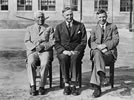Technical schools
Technical schools – which were later called polytechnics or institutes of technology – first opened in the 1880s. Run by local education boards, they provided trades training in the evening and were aimed at people who entered the workforce straight after primary school. Students paid fees to attend classes.
Pernicious idleness
The social benefits of education were an important driver of technical schools. In 1888 George Thomson, founder of the Dunedin Technical School, wrote: ‘The most casual observer cannot fail in the evening to be struck with the number of young men and lads who, for lack of better occupation in their spare hours, are chiefly engaged in “killing time”, an occupation pernicious alike to the individual and to the peace and safety of the community. Any plan … which will provide for these young people the means of self-improvement … is worthy of consideration and encouragement.’1
The first technical school was the Wellington School of Design, which opened in 1886. Many others followed and by 1904, 13,700 students were enrolled at technical classes in around 50 towns and cities. The Department of Education oversaw technical schools and controlled the way funds were spent.
Technical high schools
In 1903 the Liberal government introduced technical scholarships that covered the cost of four (and later five) years of technical education. The intention was to encourage pupils to stay at secondary school, but secondary schools concentrated more on academic subjects and were unwilling to offer technical classes.
Technical schools filled the gap. From 1905 new day classes were added for scholarship students and evening classes continued. The schools, which became known as technical high schools or colleges, were a New Zealand innovation. By 1914, 16,602 students attended evening technical classes and 1,839 attended day classes.
Over the next two decades enrolment growth was more significant in the high-school division, though evening and part-time student numbers remained higher. In 1939 there were 12,968 technical high school students, while 17,629 were enrolled at evening classes and part-day classes. The abolition of a proficiency exam (which students had to pass to move from primary to secondary school) in 1936, and the extension of the school leaving age from 14 to 15 in 1944, increased technical high school enrolments.
Post-Second World War developments
From the late 1940s trades apprentices attended part-day and evening courses at technical high schools. Technicians were educated at technical high schools from the mid-1950s and the schools also offered professional part-time courses for organisations such as the New Zealand Society of Accountants. Also, many technical students attended ‘hobby’ classes for personal interest rather than career development.
These developments boosted enrolments, which grew rapidly in the post-war period as demand for more skilled workers increased. In 1959 there were 25,304 technical high school students, and 55,540 people enrolled in part-day, evening and correspondence technical classes.
Technical institutes
In the early 1960s technical high schools in the main centres were separated into secondary schools and tertiary-level technical institutes or polytechnics. Three main factors contributed to this change:
- demand for technical education outstripped supply
- technical and secondary schools were offering similar subjects
- the tertiary sector was seen as the best place for vocational training to occur.
Tech or poly?
The new institutions were either called technical institutes or polytechnics – naming was not standardised. Auckland, Hamilton and Christchurch had technical institutes, while Wellington and Otago had polytechnics. In 1986 the Minister of Education persuaded most of the institutes to use ‘polytechnic’ but the Auckland Technical Institute (which later became Auckland University of Technology) and the Central Institute of Technology in Upper Hutt (later part of WelTec) refused.
The precursor to this was the Technical Correspondence School in Wellington, which was established in 1946 (and renamed the Open Polytechnic of New Zealand in 1990). It provided technical education for apprentices who could not access classes.
By 1970 there were eight stand-alone technical institutes in Auckland, Hamilton, Wellington, Christchurch and Dunedin, with 30,560 students enrolled. Outside the main centres, 72,724 people were enrolled part-time in the technical sections of high schools. Around half of these were in hobby classes. New institutes opened in Auckland and Wellington and in smaller centres – the first was in Palmerston North in 1971.
Community colleges
From the mid-1970s new community colleges provided continuing-education courses, many of which were non-vocational or hobby-orientated. After funding for non-vocational courses was cut in the early 1980s, community colleges mainly offered vocational courses and were indistinguishable from technical institutes. In 1990 there were 56,771 students enrolled at 25 technical institutes, polytechnics and community colleges.
